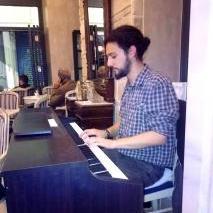Leaderboard
Popular Content
Showing content with the highest reputation on 06/18/2023 in all areas
-
Helloo! I finished a ballroom waltz suite titled Roses, Carnations and Daisies inspired by the very first bouquet I gave to my current girlfriend, and her first bouquet ever given to her. The very first and main waltz represents the Bouquet, waltz 2 is titled "The roses", waltz 3 is "The carnations", and waltz 4 is titled "Daisies". Last time I posted here I got feedback to include a section in a minor key to add even more variation. And that is what I did 😄. This is the piano version even though my waltzes are meant for orchestra. I will orchestrate it as soon as I can and share it with you guys. I am open to any feedback and suggestions 😄 Thank you so much!! Bouquet waltz.mp32 points
-
After 4 months of work I finally finished this piece 🥳 I tried using modes and a Fauré-like style2 points
-
Today I present here the third movement of my Symphony in E, just finished some days ago. Unlike the other two movements, which were composed 5 years ago and heavily and constantly revised until I posted them here, this one is actually a composition that has been done in the last 1-2 weeks and I think it's summarizes really well what I actually can do with a blank paper. It's almost 9 minutes long in a standart form (scherzo-trio-scherzo). The scherzo is more like the opposition beetwen two themes than appear many times with different modifications and character changes, and the trio is a calm section (almost in a Ländler way) being a way of getting away from turbulences in the scherzo. Actually my first motivation or starting idea was from Dvorak furiants and scherzi but ended up being something really different (but there's some evidences of this in some parts in the grouping of the bars or the accents that desestabilize the 3/4 bar. Also there's a lot of Mahler and Bruckner influence (especially in the very last bars). Hope you enjoy it! (other thing that I wanted to comment is that I uploaded the second movement in the wrong topic last time so I leave the link here so you can listen to it if you want: *Link*)1 point
-
Hi everyone, Here is the final movement of my Piano concerto in C minor. I began composing it in the first lockdown of 2020 (!), and finally managed to end this (time-consuming) work. The final movement is a rondo. I will surely write the plan of the movement in the next hours even though it is quite clear. I use the main theme of the concerto in this movement (the one of the first movement). If you want to be familiar again with the other movements of this concerto, here are the links: Finally, here are the PDF and audio of the 3rd movement:1 point
-
1 point
-
Hi here is the first section to my 51th Bagatelle. hope you enjoy and if you have any ideas for another section let me know!1 point
-
Ending is very rushed, might revise. Intended to create a very short piece, this is more of a short experiment rather than an attempt at a more encompassing work.1 point
-
Hello reader, This is my first real attempt at a large orchestral work. I took a long hiatus from composing as I stopped loving it for a while. However, I am back and continuously working on new pieces again. But let's talk about the piece. Firstly, this is not a full version. This is where I'm leaving it off until I have returned from my summer and back to uni. However, I am immensely proud of this work thus far and would like to share it with you. I am excited to hear any criticisms you might have. This piece is an attempt to tell a story about having happiness in your life but the uncertainty of being able to hold onto that happiness because it causes you to lose your happiness. To show this idea, I have two main ideas to explore. The first theme is the happiness theme, which first appears at m. 58. It is thoroughly disguised by the sections before and after making it seem less important, which is a weakness that I wasn't sure I wanted to solve. This theme reappears at measure 232 again for the loud arrival points. The second theme, which is much more obvious, is the theme at m.116. This is the desperation theme, the desire to receive happiness. This constantly reoccurs after its first arrival, notably in 214. and 298. Many more themes repeat and overlap, usually concluding at a major resolution. One thing as I work on this in the future is smoothing out some transitions, but my work is done on this for a while until I have the time.1 point
-
Link to first movement: The second movement to my C minor piano sonata is a work of great trial and error. For those just simply want to listen, please do. For those tempted by spoilers, here's such: I managed to record a semi-decent playing of the 3rd movement, so that should not take too long to be released later.1 point
-
PAC is perfect authentic cadence, which is a V-I cadence with the do (^1/^8) on top voice. ESC (essential structural closure) is a term from Sonata Theory by Hepokoski and Darcy, which simply speaking is a PAC on tonic in the 2nd subject of the recapitulation and thus the goal to reach tonic of the movement is acheived through it, hence a structural closure. Henry1 point
-
Hi @Samuel_vangogh, The thing I enjoy most is the harmony. Wonderful harmonic change throughout the movement. My fav. modulation would be b.75 when you change to c minor there. I absolutely love b.33 when cello is taking the lead with 1st violin having a countermelody. I love the motivic development and voices interacting in b.93. The hemiola in b.104 is wonderful. For me I would like to see more changes of texture here. For me many passages are having a melody taking lead, usually the 1st violin. Maybe you can have more moments like the b.93 one. The mood can change more too since mostly it's lyrical. It's beautiful but sometimes can be less beautiful when the lyricism is unchanged. So is this the prelude or the sonata movement? If this is supposed to be a sonata, is it in Sonata form? It doesn't seem like onr though. Also a sonata doesn't mandatorily has repeats for both sections. Is the tone clash of E flat and E natural in b.100 intentional? It sounds very dissonant with a minor 2nd interval. Thanks for sharing! I really enjoy this movement. Henry1 point
-
hey there I love this. I don't know much about Faure, I only know his G dorian sicilienne. I really like all the elements from his music you took. Lighter textures, modal melodies and harmony, they all sound great. Just a few thoughts: - How come you didn't change key signatures when moving to a new tonal center? It seemed like when you did, you stayed there for a while. I just thought it might be easier to read if you did. - how do you feel about key sigs with modes? I always like to keep it based on minor/major scales while writing accidentals to let you know what mode it's in, but it's just a debate I've been curious about. - I wasn't too keen on the long repeats. I feel like your piece could have been much shorter while retaining the impact you're desiring. Maybe subtle variation with the repeated sections? Overall though, this was great to listen to and I really enjoyed it. Thanks for sharing! Are there more movements coming or is this something considered stand alone? I'm satisfied with either path you take with this, well done!1 point
-
He's back. The waltz king is back. Ehm... lets get to the comments/criticism: Once again, very very very very good. I feel like a little bit more variation could be done with the accompinament so that their is some variation between each valse. Once again, this is very good Arriverderci, Arjuna.1 point
-
Updated YET AGAIN with Henry's performance. I'd just like to say that I feel so lucky @Henry Ng Tsz Kiu decided to play so many of these. Even if he stopped now, I'd be forever grateful for the generosity. I could care less about peak recording quality. I love hearing the other instruments practicing hearing his recordings, or the bench squeaking and breaths being inhaled. It makes it so much more real, like I have a bit of insight into Henry's world. This is the reason I write music, collaborations and comradery. And, hearing Henry play these so wonderfully and masterfully is a treat I don't deserve. Thanks so much Henry, I love how you only charge me $10,000 for each recording you share. There's so much passion and thought with your tempo and dynamics, Henry; it's something I could have never foreseen. You really brought these to life. I encourage anyone posting here to really prioritize playability and practicality when writing. You never know who will surprise you with their ability.1 point
-
Hi @David_DLM, This is for sure a very enjoyable set of waltzes, with the coda rounding off the previous ones. @Samuel_vangogh's advice is great too, but I'm also fine with the less advanced harmonies here since simplicity can also be beautiful as well. What I hope for it's maybe a g minor waltz before the coda, given you emphasize that g minor chord in the coda, just like what Bach did in his Mass in B minor. The change of modality will for sure make a good contrast and make the beauty more beautiful! Thanks for sharing! Hopefully you will review some of our non-waltz works too! Henry1 point
-
An interesting and beautiful piece. The contrast between that almost ethereal upper line with the interspersing block chords is very effective. Although at some points the virtual sound is less pleasing....1 point
-
Hi @SergeOfArniVillage, For me this is a very nice attempt on the whole tone scale. I like it! For me there are two distinctive elements: The whole tone running and the heavy aeolian chords. Speaking of gaslight effect, those whole tone running are like mesmerizing power of the controlling person and the aeolian chords more the heavy blow from reality; it's difficult to face it that those mesmerizing notes are in fact evil and weakening your power but you have to accept it. It's well fitting to use whole tone chord for the aimless, magical and cunning power, and the major minor chords for reality, aim. With these imagery you can say this piece is a struggle btw the two powers. The controlled wants to be free of his restraint from the controller, he struggles fiercely, but he fails at the end and once more returns to the clutches willingly. Those whole tone passages remind me of Debussy, particularly his Feux d'Artifice. The Aeolian chords remind me of Japanese Anime, but the Picardy D major chords like the one in b.28 reminds of the first mov of Beethoven's Ninth. I always love the idea of inspired by pieces on YC. That's what YC for! I don't think they are weird at all. Whole tone scales make many passgaes similar by having aimless sound, and that's what gaslight effect means. Thanks for sharing Zach! Henry1 point
-
A quite pastorale movement thusfar! I think the melodies are quite charming and the accompaniment is sometimes reminiscent of Mahler's Symphony 3 2nd movement (perhaps his most pastorale or spring-like movement that he's ever written). I like the oboe countermelody at 1:25 (measure 45) - it's a neat idea to include a canon at a 5th! I like the use of open 5ths as a kind of resonant background texture giving the melodies more beauty and room to shine. I like how you contrast the relative calm of the beginning with bombastic orchestral gestures featuring the timpani. Then you of course return to the original material. Now it seems like some kind of varied recapitulation of that bombastic material might be in order for the next section of the piece! Maybe you could use those 32nd notes you introduced in measure 77 - 78 to transition to the darker more stormy part? Good luck and thanks for sharing! Good job so far though - I love it!1 point
-
1 point
-
Here I submit the second movement of my symphony. Those two were actualy composed almost 6 years ago but I revised the structure and orchestration a few times, during this time. And now I'm kinda stuck and don't know how to go on. I had some ideas in that time about a 5 or 4 movements symphony and sketched some ideas that were dismissed. Now I'm still debating with myself if to leave it or still try some way to fulfill the project. (Currently I would like to add an scherzo and finale, or even a slow movement between those two). This movement is some way of compensating the more acumulated tension of the first one, even though it was kinda resolved at the end and in a major key almost all the time (excluding the development section). The first theme came to my mind when (in summer 2017) I was in a park in Málaga, where I live, and is like a calm looking around with curiosity to the trees and birds (even though there is no direct references to that). The contrasting section has no programme associated to it but I was ment to be still an joyful and playful contrast to the first one, with more "stress". Hope you like it! 🙂 (I'll be some weeks off so I don't know when I will reply to the comments.) Sinfonía -II a.pdf0 points




.thumb.jpg.e5f26b712b4f9622f521b10d8a53c6d6.jpg)





.thumb.png.8b5b433a341551e913a34392660bc95b.png)